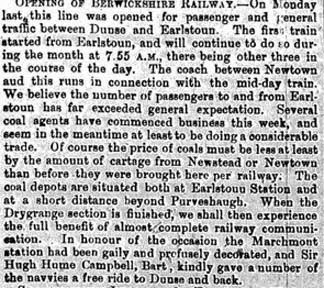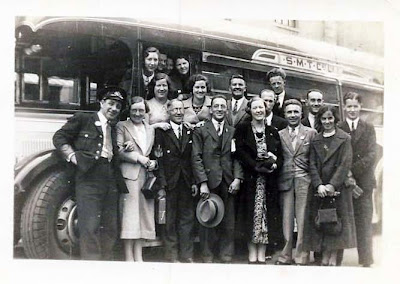Auld Earlston is grateful to Earlston Horticultural Society for getting in touch with this report and photograph on their show of 1932. It was regarded as "the finest which had been held for a long period of years" and ended in the evening with a dance to music by the Nenthorn Jazz Band. Read on below......
The Earlston Horticultural Society Committee with the Countess of
Lauderdale, who opened the show and Miss Mary Betts (Nurse Betts) who presented
the bouquet (the picture is taken at the side door of the Corn Exchange, the
site of which is now occupied by Hanover Close).
Front Row (left to right) G
Graham (treasurer), Major Sharp of The Park, Mary Betts, Countess of Lauderdale,
T Taylor (secretary), D Hogg, J Johnstone, T
Bradford.
Back Row (left to right) J
Cummings sen, J Mather, W Brockie, G Darling, R Ballantyne, W Purves, J Ross, J Cummings jun.
**********
Held in the Corn
Exchange, the opening ceremony was performed by the Countess of
Lauderdale.
Major R.W Sharp, of The
Park, presided, and a large attendance of the public was present. In his
introductory remarks, Major Sharp said it was a great privilege to introduce
the Countess of Lauderdale on the first occasion she has attended a public
function in Earlston. They all hoped it would not be the last. He noticed that
since coming to reside at Thirlestane Castle, the Countess had been taking a great deal of
interest in her home town of Lauder.
He hoped she would extend her interest to include the sister town of Earlston.
The Countess
thanked Major Sharp for his kind words, and expressed her pleasure in coming to
the show. She was taking every opportunity of meeting her neighbours. The
Earlston Show was one of the great functions of the year, and was reckoned as
one of the best in the Borders. The standard of the exhibits had always been
high, and from what she had seen it was higher than ever this year. The
countess was only starting her gardening career, and was somewhat of a novice,
but she was hoping to get a few tips today, and probably next year she would
come back as a competitor and clear the decks. There is nothing better for
people than taking a great interest in their gardens, and the Society was
giving encouragement in this direction. She was pleased to see that the young
people were being encouraged, and it was gratifying to see their splendid
exhibits. She had much pleasure in declaring the show open, and wished it
all success in the future.
A lovely bouquet was presented to the Countess by
Mary Betts, the youthful daughter of one of the chief exhibitors. On the call
of Mr Tom Bradford, a cordial vote of thanks was given to the Countess of
Lauderdale, and also to Major Sharp.
The report in The Border Telegaph" noted that the show was
one of the finest which has been held for a long period of years. No doubt the
season has been favourable for horticulturists, but several young members have
begun to take an interest, and their exhibits were extraordinarily fine. The
vegetable section has always been a feature of the show, and this year was no
exception, and in all classes competition was very keen. J.R Hope, of Wester
Housebyres, a new exhibitor staged a lot of splendid vegetables. For a year or
two the cut flower section has been rather weak. On the present occasion, the
reverse has been the case, as the exhibits would have held their own in shows
of a larger size. The outstanding features were the sweet peas shown by John
Johnston, Carolside, who again won the cup presented by the Countess of
Lauderdale, and the gladiolii shown by Willie Brockie. The latter gentleman had
some very magnificent spikes. Pot plants were, as usual, somewhat limited in
competition. Fruit was scarcely up to the best standard, but the industrial
section upheld its honourable place.
During the
afternoon the show was well patronised. Musical sections were provided by Mr
Fisher’s Orchestra. At the close of the show, a dance was held, for which the
music was provided by the Nenthorn Jazz Band. A great deal of the success of
the exhibition was due to the untiring work of Tom Taylor, secretary, and
George Graham, treasurer.
Earlston Horticultural Society would like to thank Mrs Margaret Wilson, for
providing the photograph and report featured.
*********
The Society continues to be active in the village with an Annual Plant Sale and Coffee Morning mid May and its Annual Flower Show held on the last Saturday in August.
**********

































